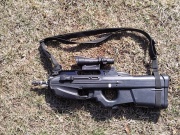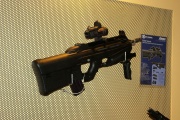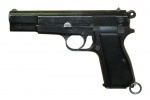FN F2000
| FN 2000 | |
|---|---|

| |
| The FS2000 carbine | |
|
| |
| Type | Bullpup assault rifle |
| Land of Origin | Belgium |
| Specifications | |
| Length | |
| Barrel length | |
| Weight | |
| Width | 81.3 mm (3.2 in) [3] |
| Height | 259.1 mm (10.2 in) [3] |
| Cartridge | 5.56x45mm NATO [5] |
| Action | Gas-operated, rotating bolt [5] |
| Rifling/Twist | 6-groove, 7" (180mm), right[6] |
|
| |
| Rate of Fire | 850 rounds/min |
| Muzzle velocity | 900 m/s (2,953 ft/s) |
| Effective Range | 500m (547 yd)[6] |
| Max. Range | 3000m (3280 yd)[6] |
| Feed | Detachable box magazines; capacities: |
| Sights | sights= 1.6x magnified telescopic sight, notch back-up sight |
| Service History | |
| Used by | See Users |
| Wars | |
| Production History | |
| Design Date | 1995–2001 |
| Manufacturer | FN Herstal |
| Produced | 2001–present |
| Variants | See Variants: |
Contents[hide] |
[edit] Design details
The F2000 is a modular weapon system; its principal component is a compact 5.56x45mm NATO-caliber assault rifle configured in a bullpup layout. The F2000 is a selective fire weapon operating from a closed bolt.
The rifle consists of two main assemblies: the barreled receiver group and the frame, coupled together by means of an axis pin located above the trigger guard. The barrel group has an integral MIL-STD-1913 Picatinny rail used to mount optical sights. The frame or lower receiver contains the trigger group, the bolt and bolt carrier assembly, return mechanism and magazine well. A removable handguard is installed in front of the trigger which completes and encloses the trigger guard.
[edit] Features
The F2000 is a gas operated, fully-automatic and ambidextrous bullpup rifle. Both the safety system and trigger mechanism were adopted from the P90 submachine gun; the selector toggle is a rotating disc located below the trigger. The fire selector doubles as the weapon’s manual safety and secures the firearm against accidental discharge (the selector/safety disc has 3 settings: "S"—safe, "1"—semi-automatic mode, "A"—fully automatic fire). The "safe" setting disables the trigger. The hammers group pins and springs are steel while all other components are nylon injection molding. The shell of the rifle is made of composite materials.
The F2000 is fed from standard NATO box magazines (STANAG 4179) with a 30-round cartridge capacity using 5.56x45mm ammunition. The magazine catch/release button is installed symmetrically in the pistol grip, in front of the magazine; the magazine catch is operated by an oversized actuator used when wearing NBC gloves. The F2000 is not configured from the factory to have a drop-free magazine system due to the friction from the removable dust gaskets. The magazine needs to be pulled out manually.
The rifle does not have a hold-open device; the bolt does not stay back after the last round is fired. The cocking handle is placed on the left side of the receiver, just above the handguard, and can be operated by left-handed shooters. There are no access points for the possible ingress of dirt or debris; the cocking handle slot is sealed.
The weapon’s primary sight is a telescopic sight with a fixed 1.6x magnification (the reticle also enables use in low-light conditions) contained in a plastic housing above the receiver (mounted on the MIL-STD-1913 rail), the secondary sight is a non-adjustable fixed notch and front blade, molded into the optical sight housing cover. The sight cover and sight module can be quickly removed to reveal the Picatinny rail.
The rifle’s chromed hammer-forged steel barrel is stated to retain accuracy after 20,000 normal (non-sustained) rounds. The barrel also features a flash suppressor with an angled cut at the tip which directs the muzzle blast upward, compensating for muzzle rise. The F2000 has an optional bayonet lug mounted near the muzzle, and an adjustable gas regulator with two settings: "normal" for standard ammunition meeting NATO specifications, and "adverse"—used to send an increased volume of gas into the system to ensure proper functioning when fouled or when using low pressure ammunition.
[edit] Operating mechanism
This selective fire weapon is a gas-operated design utilizing a short-stroke piston system driven by propellant gases diverted into the gas cylinder through a port in the barrel; it fires from a closed bolt position. The weapon is locked with a rotating bolt which features 7 radial locking lugs, a spring-powered extractor and ejector. The chamber, bolt, and ejector mechanism can be accessed by flipping up a hinged inspection cover in the receiver, behind the optical sight housing.
The F2000 uses a unique ejection system, ejecting spent cartridge casings forward and to the right side of the weapon—through a tube running alongside the barrel. This method of ejection provides for fully ambidextrous operation; the rifle can be used without any modification by both right and left-handed shooters. This ejection pattern was achieved by using a swiveling polymer tray, which intercepts the empty casing from the bolt face immediately after disengaging from the extractor. As the empty casing is extracted it is held while the rocker assembly tilts to lift it above and clear of the feed path as the next round is stripped from the magazine by the bolt head. The casing is fed into the tray located in a cavity in the receiver wall, which then pivots the cartridge case and directs it into a chute (above the barrel); the case is discarded from the tilting tray by being impacted by a pin on the moving bolt carrier upon its forward return. Only when the ejection tube contains more than five cases is the first of them ejected forward through a port just behind and to the right of the muzzle.
This system is patent protected (patent number 5675924 dated 14 October 1997 by René Predazzer[7] and patent 6389725 from February 25, 2000, author – Charles Denuit).[8] The ambidexterity provided by forward ejection is its most obvious benefit, and removes many of the tactical and user difficulties (such as lack of ambidexterity, inability to shoot around corners, and gas and debris released in close proximity to the shooter’s face) that bullpup designs usually create.
[edit] Grenade launcher
One of the modules developed for the F2000 system is a proprietary lightweight 40 mm under-slung GL1 grenade launcher (empty weight—1 kg) that uses standard low-velocity 40x46mm grenades.[9] The launcher is a single-shot breech-loaded pump-action weapon with a barrel that slides forward for loading and unloading (like the M203 grenade launcher), locked by axial rotation of the barrel.
The grenade launcher's trigger is installed directly under the F2000's trigger so that it can be manipulated without removing the shooting hand from the rifle’s pistol grip. The double-action trigger lets the operator "try again" if the grenade's percussion type primer doesn't ignite. The breech release button is found on the left side of the launcher body, like on the M203. The grenade launcher comes with a basic flip-up ladder sight, but it was intended to be used with a specially-designed optoelectronic fire control system designated FCS, developed in cooperation with the Finnish company Noptel.
The aiming module is installed in place of the standard optical sight and becomes the weapon’s primary sight when mounted, but its main purpose is to accurately determine and indicate the range of a grenade target. The module is powered by a 9 V battery pack, installed in the stock, behind the magazine well. The power pack is also intended to power any other tactical accessories or systems that could be introduced. The FCS integrates a low-power laser rangefinder (precise to within ± 1 m), a day-time aiming channel with an electronically projected reticle, a measured range display reading and a diode elevation adjustment indicator.
The fire control system calculates a firing solution manifested by the barrel’s angle of elevation using target range information from the laser rangefinder (the rangefinder is activated by pushing a button on the pistol grip, below the trigger), corrected manually by the shooter through a push-button interface (add/subtract buttons) on the FCS top cover to take account for head or tail winds that could affect the desired range. The F2000 FCS also contains software with the ballistic properties of up to six types of 40 mm grenades and can be reprogrammed to take advantage of future munition improvements. Batteries for the FCS are located in the bottom of the buttstock.
After obtaining a range measurement, the distance to the target is displayed on a liquid crystal screen and the elevation diode flashes red. Once a correct elevation has been achieved by tilting the rifle, the diode changes color to green indicating the weapon is ready to fire. A further three signaling diodes have been installed on the top of the FCS unit, enabling accurate firing from the hip. The fire control computer makes firing regular grenades accurately much easier, though it cannot launch smart grenades. The FCS is under continuous development and newer versions differ somewhat from the original concept.
A 3-shot grenade launcher is also being developed for the weapon (in 40 mm). The rifle can also be adapted for police operations by using under-slung modules with a 12-gauge 5-shot shotgun or a .68-caliber less-lethal FN 303 pneumatic launcher. A module with a 20 mm grenade launcher is also planned (using 20x28mm ammunition from the OICW program) with an integrated FCS unit.
[edit] Variants
[edit] F2000 Tactical
The F2000 Tactical railed variant is similar to the standard model, but it lacks the optical sight, and comes instead with an extended top receiver MIL-STD-1913 rail with flip-up iron sights.[10]
[edit] FS2000
The FS2000 is a civilian-legal, semi-automatic version of the F2000 that first became available in June 2006. The FS2000 Tactical model is equipped with an extended barrel with a permanently attached flash suppressor and a 1:7 in right hand twist rifling rate; the bayonet lug was not included on the FS2000 rifles. The lower hand guard can be removed in the same manner as the F2000 to accept the same variety of accessories. It comes with a Picatinny rail optic rail along with backup iron sights. The rear flip-up National Match-sized aperture is adjustable for windage, while the removable front sight is adjustable for elevation.[11] A small number of the early models featured a stepped barrel contour as well as a demilled bayonet lug.[11] Measurements on the stepped barrel's rifling were as long as the non-stepped barrel, revealing that the stepped barrel is not simply a shorter F2000 military barrel with an extended flash hider.[11]
A variant of the FS2000, called the FS2000 Standard, is equipped with the factory F2000 1.6x magnification optic and sight cover.[12] It does not contain the grenade launcher computer.
[edit] Users
- Belgium: Used by the Special Forces Group of the Belgian Armed Forces Land Component.[13]
- Chile: Special forces.[14]
- Croatia: The Croatian Army tested the rifle in 2006. As of 2008, the 1st Airborne Company of the Special Operations Battalion is the only army unit equipped with this weapon. According to unofficial estimates, 100 rifles have been purchased.
- India: Used by the Special Protection Group.[15]
- Libya: Purchased a number of F2000 assault rifles along with other assorted lethal and non-lethal systems from FN Herstal in 2008 with deliveries slated to begin in April 2009. The export of the weapons was initially blocked over concerns of proliferation into other volatile regions.[16]
- Pakistan: Special forces.[14]
- Peru: Special forces.[14]
- Poland: In limited use by the GROM special forces group.
- Saudi Arabia: The Saudi Arabian National Guard purchased 55,000 rifles in 2005.
- Slovenia: In June 2006, the ministry of defence of the Republic of Slovenia signed a contract with FN Herstal involving the acquisition of 6,500 F2000 rifles as the new standard service rifle for the Slovenian Army (Slovenska vojska) along with the 40mm LG1 grenade launcher. This is arguably the first confirmed large-scale adoption for this rifle by a European and NATO member country. The basic F2000 Tactical model was upgraded according to Slovenian specifications and designated F2000 S, the most apparent feature being a raised Picatinny rail also functioning as a carrying handle. The rifle debuted on 25 July 2007. Rearmament was completed by the end of 2007. In 2012 the Slovenian army is going to equip its reserve forces with the F2000 S as well. The Slovenian army will ultimately purchase 14,000 rifles.
[edit] Resources

This article or section is missing resources, such as diagrams or manual links, and could use more input to fill in the missing bits. You (yes, you!) can help Gunsopedia provide more comprehensive information to our users by using your own knowledge to add to it.
[edit] References
- ↑ 1.0 1.1 FN F2000 Rifles - F2000, FNH USA, 2010
- ↑ 2.0 2.1 FN F2000 Rifles - F2000 Tactical, FNH USA, 2010
- ↑ 3.0 3.1 3.2 3.3 3.4 3.5 3.6 FN FS2000 Carbines, FNH USA, 2010
- ↑ 4.0 4.1 FN FS2000 Carbines - FS2000 Tactical, FNH USA, 2010
- ↑ 5.0 5.1 5.2 5.3 5.4 5.5 FN F2000 Rifles, FNH USA, 2010
- ↑ 6.0 6.1 6.2 Data taken from FS2000 carbine owner's manual
- ↑ Ejection device for firearm. Predazzer, Rene. Google Patent Search.
- ↑ Fire arm with forward ejection or ejection brought to the fore-part of the fire arm. Denuit, Charles. Google Patent Search.
- ↑ GL1 40mm LV, FNHerstal.com
- ↑ Official FNH USA FN F2000 Tactical, Fabrique Nationale USA
- ↑ 11.0 11.1 11.2 The FN FS 2000 is the civilian-legal, semi-automatic version of the F2000 that first became available in June 2006 manufactured by Fabrique Nationale de Herstal (FN Herstal) Guns Lot
- ↑ Michael O. Humphries, FNH USA FS2000 Standard, American Rifleman
- ↑ Landcomponent Landcomponent Onderwerp Bewapening F 2000 mil.be
- ↑ 14.0 14.1 14.2 Belgian bullpup: FN Herstal FS2000: its appearance is wild, its engineering impressive. And you can have a semi-auto version, if you can find one!
- ↑ If looks could kill, India Today, 2008-08-22
- ↑ Une licence d'exportation de la FN bloquée par la Région (French) Express.be
[edit] External links
- Official website
- Official website (United States)
- FN FS2000 Owner's Manual
- FN FS2000 Standard (American Rifleman article)
- FN Herstal Fire Control System
[edit] Video
- FN FS2000 Product Video (Civilian Standard Model - Semi-auto)
- FN FS2000 Tactical Product Video (Civilian Tactical Model - Semi-auto)
| [show]This article is part of a series on FN Herstal firearms |
|---|
| [show]This article is part of a series on Bullpup firearms |
|---|



